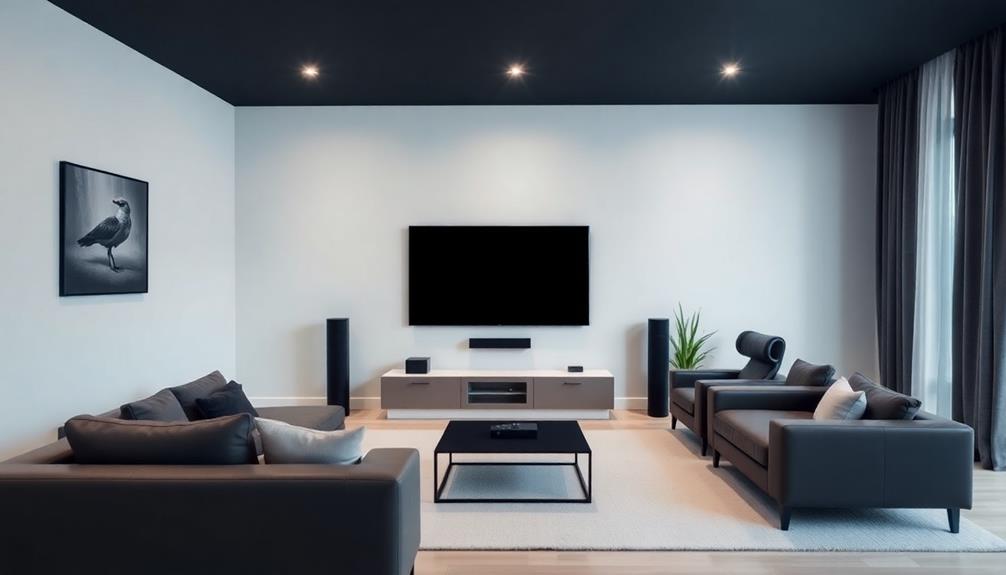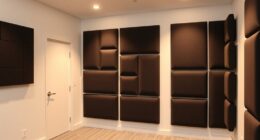Smart projectors are changing how you enjoy movies and presentations. With built-in streaming apps like Netflix and YouTube, accessing your favorite content is just a tap away. Their high-resolution displays, ranging from 1080P to true 4K, guarantee stunning visuals, while wireless connectivity makes setup a breeze. You'll love features like auto keystone correction for perfect images in any setting. Plus, Bluetooth enhances the audio experience by connecting to external speakers. Whether for work or play, smart projectors offer convenience and quality that elevate your viewing. Stick around to uncover more about optimizing your projector experience.
Key Takeaways
- Smart projectors integrate built-in streaming apps, allowing direct access to platforms like Netflix and YouTube without additional devices.
- Wireless connectivity options, including WiFi 6 and Bluetooth, facilitate smooth streaming and connection to external audio devices.
- Features like auto keystone correction ensure optimal image clarity, enhancing both entertainment and professional presentations.
- User-friendly interfaces and voice control options simplify navigation and improve accessibility for all users.
- Regular software updates provide ongoing enhancements, ensuring compatibility with new apps and improved security measures.
Overview of Smart Projectors
Smart projectors are revolutionizing the way you experience visual content, combining cutting-edge display technology with user-friendly features. These devices offer an immersive viewing experience that transforms your home theater or outdoor movie nights into something extraordinary.
With support for high resolutions like 1080P and 4K, smart projectors deliver stunning image quality and vibrant colors, ensuring every detail pops. Additionally, integrating a powerful home theater setup can greatly enhance the overall experience by improving sound quality and immersion.
Gone are the days of fumbling with multiple devices; many smart projectors come equipped with built-in streaming apps such as Netflix and YouTube. This integration simplifies content access and enhances user experiences by allowing you to stream directly without needing additional gadgets.
Plus, with WiFi and Bluetooth connectivity, you can easily sync your devices for a seamless viewing experience. Smart projectors also feature auto keystone correction and auto focus functionalities, making it easy to achieve ideal image clarity and alignment with minimal manual effort.
Their portable design, weighing as little as 2.35 pounds, means you can effortlessly move them between various indoor and outdoor settings. Whether you're hosting a movie night or enjoying a spontaneous outdoor screening, smart projectors offer versatility and convenience.
Key Features of Smart Projectors

When you're looking at smart projectors, the integration of streaming apps and wireless connectivity options really stands out.
With apps like Netflix and YouTube built right in, you can enjoy your favorite shows without extra devices. Additionally, many smart projectors come with air quality indicators that help guarantee a comfortable viewing environment.
Plus, the latest wireless tech assures you get smooth streaming with minimal lag, making your viewing experience even better.
Streaming App Integration
Today's projectors have really stepped up their game with streaming app integration, making it easier than ever to plunge into your favorite shows and movies.
Smart projectors, like the PHILIPS Android TV Projector, come preloaded with popular streaming apps such as Netflix and YouTube, so you can access content without needing extra devices. With built-in WiFi, these projectors support high-speed streaming through 5G connections, ensuring smooth playback of HD content. This advancement in technology mirrors the emotional resonance often found in animated films, creating an engaging viewing atmosphere.
Bluetooth connectivity allows you to connect external speakers or headphones for enhanced audio experiences while streaming.
Advanced models also feature auto keystone correction, which automatically adjusts the image for a perfect fit, and screen mirroring options that let you share content directly from your smartphone or laptop with ease.
Additionally, the integration of HDMI and USB ports in smart projectors enhances overall usability, allowing you to connect various media devices effortlessly.
This combination of features transforms your viewing experience, making it not just easy but also enjoyable. Whether you're binge-watching a series or enjoying a movie night, the streaming app integration in smart projectors offers convenience and quality like never before.
Wireless Connectivity Options
While enjoying a movie night or giving a presentation, having reliable wireless connectivity options can greatly enhance your experience. Smart projectors come equipped with advanced features like WiFi 6 technology, allowing for dual-band connections (5G and 2.4G), which contributes to improved user experience by providing smoother streaming and reduced lag, so you can focus on the content rather than technical issues.
Bluetooth support in these projectors lets you connect wirelessly to external speakers, headphones, or soundbars, elevating your audio experience without the hassle of messy cables. You can also easily share content from your smartphone or tablet using screen mirroring, making it perfect for group viewings or quick presentations.
When it comes to versatile connectivity, smart projectors typically include HDMI, USB, VGA, and MicroSD ports, allowing you to hook up various devices like gaming consoles or streaming sticks. Some even feature USB-C ports, providing simultaneous charging and screen mirroring for your modern devices.
With these options, you can create a seamless entertainment setup that meets all your viewing needs. Embrace the convenience of wireless connectivity and elevate your projector experience today!
Benefits of Using Projector Apps

Using projector apps transforms your viewing experience by streamlining access to popular streaming services like Netflix and YouTube. With these apps, you can enjoy seamless streaming directly from smart projectors, eliminating the need for extra devices and simplifying the viewing experience.
Many modern projectors, such as the PHILIPS Android TV Projector, come with preloaded apps and 5G WiFi chips, enhancing user convenience with stable, lag-free streaming. Additionally, the integration of AI advancements in technology guarantees that these apps continually improve user experience by adapting to emerging needs and preferences.
Projector apps also support wireless screen sharing from smartphones and tablets, allowing you to display content effortlessly without the hassle of cables. This feature is particularly useful for presentations or sharing videos with friends.
With the auto keystone correction feature, you can achieve ideal image alignment and clarity with minimal manual adjustments, making setup a breeze.
Moreover, some projector apps provide interactive functionalities like real-time collaboration tools, fostering engagement and productivity in educational and business settings. The user-friendly interface guarantees that you can navigate through apps easily, further enhancing your overall experience.
Comparing Smart Projectors

When you're comparing smart projectors, you'll want to focus on key features like resolution and auto keystone correction.
A well-designed workspace, like a cottagecore home office, can enhance your overall viewing experience by creating a serene atmosphere.
It's also important to evaluate connectivity options, such as HDMI and WiFi capabilities, to guarantee compatibility with your devices.
Key Features Overview
Smart projectors stand out in the domain of home entertainment by combining cutting-edge technology with user-friendly features. With advancements like auto keystone correction, these devices guarantee that you enjoy a clear and undistorted image, enhancing your viewing experience.
Many smart projectors support high-resolution 1080P Full HD and even 4K, delivering vibrant colors and sharp details, thanks to impressive contrast ratios of 10,000:1. Additionally, just like heat pump advancements that improve efficiency, smart projectors incorporate innovative technologies for peak performance.
Built-in streaming apps make it simple to access popular platforms like Netflix and YouTube without needing extra devices. Imagine just pressing a button and diving straight into your favorite shows!
Plus, with Bluetooth capabilities, connecting to audio devices or other peripherals is a breeze.
Many models are compact and portable, allowing you to set them up easily in various environments. Whether you're hosting a movie night indoors or setting up for an outdoor screening, these smart projectors adapt to your needs.
Connectivity Options Comparison
The connectivity options available in smart projectors play an essential role in enhancing your viewing experience. Modern smart projectors typically feature multiple connectivity options, including HDMI, USB, and Wi-Fi, allowing you to connect devices like smartphones, tablets, and laptops seamlessly.
Many of the latest models support Wi-Fi 6, providing dual-band connectivity (5G and 2.4G) for quicker streaming and reduced lag, which is a significant upgrade over older standards. Additionally, smart projectors with Bluetooth functionality can create a cleaner setup, similar to how vacuums with a self-cleaning mechanism minimize maintenance efforts, enhancing the overall convenience.
Bluetooth functionality is another game-changer, enabling you to connect wireless speakers or headphones for enhancing audio without the clutter of cables. This makes your home entertainment setup cleaner and more efficient.
Additionally, screen mirroring capabilities allow for instant casting of mobile content onto larger displays, making it perfect for presentations or group viewing. Compatibility with streaming devices like Chromecast and Apple TV through USB ports further enhances the versatility of smart projectors, enabling direct access to popular streaming services without needing extra hardware.
With these diverse connectivity options, smart projectors become a crucial part of your entertainment experience, ensuring convenience and adaptability to suit your needs.
Performance Evaluation Criteria
Evaluating performance criteria for projectors is essential for ensuring you get the best viewing experience tailored to your needs. Start by considering brightness, measured in lumens; higher levels are important for well-lit environments to maintain clear image quality.
Additionally, understanding the impact of eco-friendly energy sources can enhance your viewing setup by integrating renewable energy solutions.
Next, resolution plays a critical role—true 4K projectors with native UHD resolution offer superior image clarity compared to basic or mini projectors, which often fall short.
Don't overlook the contrast ratio, ideally above 10,000:1, as it greatly enhances the vibrancy and depth of colors in projected images, enriching your overall viewing experience.
Connectivity options are also key; look for projectors with HDMI 2.0 and USB-C ports to support various media sources and integrate seamlessly with streaming devices.
Connecting Devices to Your Projector

While connecting devices to your projector might seem challenging at first, it's actually a straightforward process thanks to the variety of connectivity options available. Most modern projectors, like the PHILIPS Android TV Projector, support multiple methods such as HDMI, USB, and even WiFi. This means you can easily connect your devices for streaming content or sharing presentations.
Here's a quick overview of common connectivity options:
| Connection Type | Description | Smart Features |
|---|---|---|
| HDMI | Standard for video and audio | High-definition streaming |
| USB Type-C | Direct playback from smartphones | Faster data transfer |
| WiFi | Wireless internet connection | Stream content without cables |
| Bluetooth | Connect speakers or headphones | Enhanced audio experiences |
| Screen Mirroring | Mirror content from your device | Simple sharing with no wires |
With WiFi capabilities, particularly WiFi 6, you'll experience faster streaming and reduced lag during content mirroring. If you prefer a wireless setup, Bluetooth allows you to connect to compatible audio devices for an enhanced audio experience. So, whether you're gaming, watching movies, or giving a presentation, connecting your devices is a breeze!
Enhancing Audio and Visuals

To elevate your viewing experience, you can focus on both audio and visual enhancements that modern projectors offer. High-resolution displays, like those with 1080P or 4K support, provide sharp and vibrant images, greatly boosting your projection quality for movies and gaming.
Additionally, projectors with smart features can enhance your experience with advanced cleaning technologies that maintain a clear image. Projectors equipped with advanced smart projector features, such as a contrast ratio of 10,000:1, deliver lifelike visuals with improved depth and color vibrancy.
To further improve your experience, consider projectors with built-in audio systems, like 5W speakers, which provide multi-directional sound. This can create an immersive cinematic experience without the need for external speakers.
If you want to take audio to the next level, Bluetooth connectivity allows you to easily connect to external sound systems or headphones, enriching your sound experience.
Moreover, advanced imaging technologies, including auto keystone correction, guarantee that the projected image is clear and well-aligned, regardless of your viewing angle.
This combination of high-resolution displays, superior audio, and smart projector features assures you'll enjoy an engaging viewing experience every time you turn on your projector.
Smart Projector Use Cases

Smart projectors have become essential tools for a variety of settings, transforming how you experience entertainment and presentations. Whether you're looking to host an outdoor movie night or deliver a stunning business presentation, smart projectors elevate your viewing experience.
With their built-in streaming apps, like Netflix and YouTube, you can dive straight into your favorite shows without needing any external devices.
Imagine setting up an outdoor movie projector in your backyard, effortlessly connecting through wireless connectivity. The 270° adjustable design allows for versatile projection angles, making it easy to find the perfect setup for any environment. Plus, with HDMI compatibility, you can connect your smartphone, laptop, or gaming console with ease.
One of the standout features of smart projectors is auto keystone correction. This technology automatically adjusts the image, eliminating distortion and ensuring a clear, well-aligned display.
Whether you're creating an immersive cinematic experience for friends or delivering a professional presentation, smart features make your life easier and more enjoyable. Embrace the potential of smart projectors and transform your viewing experience in various settings today!
Choosing the Right Projector

Selecting the right projector can greatly enhance your viewing experience, whether you're enjoying a movie at home or presenting in a professional setting.
Start by considering the brightness level, measured in ANSI lumens. For home theaters, a projector with around 400 ANSI lumens will deliver clear images even in ambient light.
Next, focus on high resolution; look for models that support 1080P or 4K technology to guarantee sharp, detailed visuals.
Don't overlook the contrast ratio, ideally above 10,000:1, which enhances picture depth and makes colors pop, creating a more lifelike experience.
Additionally, evaluate the connectivity options available—HDMI, USB, and wireless capabilities are essential for seamless integration with devices like smartphones and gaming consoles.
Future of Projector Technology

The future of projector technology promises an exciting evolution in how you experience visual content. With advancements in various areas, you can look forward to:
- True 4K Projectors: These are becoming more accessible and affordable, ensuring superior image quality for your movies and presentations.
- Smart Features: Built-in streaming apps and voice control will simplify your access to content, enhancing your viewing experience.
- Enhanced Connectivity: With WiFi 6 and Bluetooth 5.2, you'll enjoy faster, more reliable streaming capabilities, reducing lag and improving performance.
Moreover, the shift towards lamp-free light sources, like LEDs and RGB lasers, means longer lifespans and better color vibrancy.
You won't just benefit from eco-friendly options but also from cost-effectiveness in the long run. Future projectors are also set to include advanced functionalities such as auto focus and auto keystone correction, making setup easier than ever.
With these innovations, you'll be able to enjoy a hassle-free experience, focusing more on the content rather than the technology. Get ready for a new era of projection that genuinely enhances your viewing experience!
Conclusion
In summary, smart projectors are transforming how we enjoy content, making it easier than ever to connect and customize your viewing experience. Did you know that by 2024, experts predict that over 50% of households will own a smart projector? With their innovative features, projector apps, and enhanced audio-visual capabilities, you can elevate movie nights and presentations alike. So, take the plunge and choose the right projector to access a world of entertainment possibilities right in your home!
Hello, I’m Art, and I’m excited to be a part of the 1Home Theatre Projector team. As a writer, I’m here to contribute my knowledge and insights to help you achieve the ultimate home cinema experience. I understand that making decisions in the world of home entertainment can be complex, and I’m here to simplify the process for you.
















